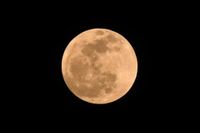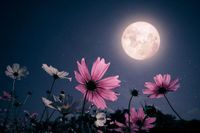As spring unfolds, sky enthusiasts around the globe are preparing for a celestial event that promises to light up the night sky. This weekend, the first full moon of spring, commonly referred to as the "pink moon," will grace the heavens. Set to peak on Saturday, April 12, 2025, at 8:22 p.m. ET (00:22 GMT on April 13), this full moon is not only a treat for the eyes but also carries significant cultural and religious importance.
The term "pink moon" derives from the early spring bloom of the creeping phlox (scientific name: Phlox subulata), a wildflower native to eastern North America. While the moon will not actually appear pink, its name reflects the vibrant colors of spring flowers that begin to bloom around this time. According to the Old Farmer’s Almanac, the pink moon has been celebrated in various cultures and traditions, marking an important seasonal transition.
This year's pink moon is also designated as a "micromoon," which occurs when the moon is at its farthest point from Earth, about 406,007 kilometers away. This distance causes the moon to appear smaller and dimmer than usual—up to 14% smaller and 30% dimmer compared to a supermoon, which happens when the moon is at its closest point to Earth. Alain Brizard, an astrophysicist, notes that while the difference is subtle, it is noticeable to keen observers.
Additionally, the pink moon holds religious significance as it coincides with the Paschal moon, which is used to determine the date of Easter. This year, Easter Sunday will fall on April 20, 2025, the first Sunday after the pink moon. The relationship between the Paschal moon and Easter is rooted in tradition; if the full moon occurs in March, Easter is celebrated that month. However, if it falls in April, as it does this year, Easter is celebrated the following Sunday.
Moreover, the pink moon's appearance aligns with the start of the Jewish holiday Passover, which begins on April 12, 2025. This convergence of significant dates adds to the moon's cultural weight, making it a focal point for various celebrations and observances.
For those eager to catch a glimpse of this celestial spectacle, the best viewing locations are open fields or elevated areas with an unobstructed view of the eastern horizon. While the full moon will be visible to the naked eye, binoculars or a telescope can enhance the experience by revealing more details of the lunar surface.
Skywatchers across North America will have an excellent opportunity to view the pink moon as it rises. However, those on the West Coast may find it challenging to see the moon in its full glory during the night hours, as the peak occurs at 5:22 p.m. PST. In contrast, viewers in Europe will witness the pink moon on Sunday, April 13, 2025, with the peak occurring at 2:22 a.m. GMT.
As the pink moon illuminates the night sky, it will share the spotlight with Spica, the brightest star in the constellation Virgo. For North American viewers, Spica will appear to the upper left of the pink moon, while those in Europe will see it on the lower left side. Unfortunately, viewers in South America will not have the chance to see Spica alongside the moon.
From Thursday, April 10, 2025, to Monday, April 14, 2025, the moon will shine brightly, illuminating to 95% or more of totality. During this period, skywatchers can enjoy the beauty of the moon in various phases, culminating in the full moon on Saturday night.
In conclusion, the pink moon serves as a reminder of the changing seasons and the beauty of nature. It is a time for reflection, celebration, and connection with both the cosmos and the traditions that shape our lives. As you prepare to gaze at the night sky this weekend, take a moment to appreciate the wonders of the universe and the rich tapestry of cultural significance woven into this celestial event.




